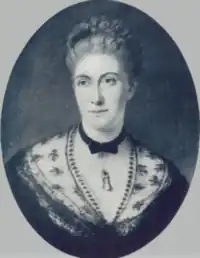Princess Claudine of Teck
Princess Claudine of Teck (Claudine Henriette, 11 February 1836 – 18 November 1894), known as Countess Claudine von Hohenstein until 1863, was a 19th-century Austrian noblewoman directly related to German and British royalty.[1]
| Princess Claudine of Teck | |||||
|---|---|---|---|---|---|
 Portrait by Sydney Hodges | |||||
| Born | Countess Claudine von Hohenstein 11 February 1836 | ||||
| Died | 18 November 1894 (aged 58) Graz, Austro-Hungarian Empire | ||||
| |||||
| House | Teck | ||||
| Father | Duke Alexander of Württemberg | ||||
| Mother | Countess Claudine Rhédey von Kis-Rhéde | ||||
Family
She was the first-born of the children of the morganatic marriage formed by Duke Alexander of Württemberg and Countess Claudine von Hohenstein (born Countess Claudine Rhédey von Kis-Rhéde). This marriage had a morganatic character, so that neither the wife nor the children would be considered members of the Royal House of Württemberg. She had two younger siblings, a brother and a sister:[1]
- Francis, later Duke of Teck (1837–1900), married to Princess Mary Adelaide of Cambridge
- Countess Amalie of Hohenstein (1838–1893), married to Count Paul von Hügel
Her father was an officer in the army of the Austrian Empire and her mother belonged to the Hungarian nobility. For this reason the marriage was established in Vienna. Her mother was awarded the title of Countess of Hohenstein by Ferdinand I of Austria on May 16, 1835, fourteen days after their wedding.[2]
Biography
Her childhood and early youth were spent in Vienna with her parents and siblings. Her mother died in 1841, as a result of an accident in which she was run over by horses. Her sister Amelia's marriage to Baron (later Count) Paul von Hügel and their transfer to Reinthal Castle near Graz, led her to take up residence in a Swiss-style chalet a short distance from her sister.[3]
On 1 December 1863, her father’s cousin King William I of Württemberg granted Claudine and her brother Francis the title and rank of princes (fürst) of Teck, with the style of Serene Highness.[4]
Claudine had a great fondness for gardening and farming. In her residence she had a farm. Her life was spent with her sister's family (her husband and their only child, Paul Julius (1872–1912) known as Bubi). They alternated local life with occasional family visits such as those of the family of her brother Francis and his wife Mary Adelaide and their children, among whom was Princess Mary, future queen consort of the United Kingdom.[3] In the fall of 1869 she visited the United Kingdom invited by her brother Francis and sister-in-law. The visit lasted until the new year (1870) and included a short stay in Windsor Castle summoned by Queen Victoria.[5]
She died of diphtheria on 18 November 1894, fourteen months after the death of her sister Amelia in 1893.[6] Previously, on 10 November 1893, she had made a will.[7]
Titles and styles
References
- "Claudine von Württemberg". roglo.eu. Retrieved 2020-08-26.
- Gothaischer Hofkalender: genealogisches Taschenbuch der fürstlichen Häuser (in German). Perthes. 1890. pp. 375–376.
- Pope-Hennessy, James (1959). "Book I. Princess May. 4. Rumpenheim, Neustrelitz and Reinthal. VI". Queen Mary. London. p. 105.
{{cite book}}: CS1 maint: location missing publisher (link) - "Nichtamtlicher Theil". Wiener Zeitung (in German). 5 January 1864. p. 35.
- Kinloch-Cooke, Clement (1900). A memoir by Her Royal Highness Princess Mary Adelaide Duchess of Teck. New York, London: Charles Scribner's Sons [New York], John Murray [London]. pp. 21–27.
- Pope-Hennessy, James (1959). "Book I. Princess May. 4. Rumpenheim, Neustrelitz and Reinthal. VI". Queen Mary. London. pp. 105–106.
{{cite book}}: CS1 maint: location missing publisher (link) - "Teck, Fürsten von Staatsangehörigkeit der Fürstin Claudine von Teck und ihres Gemahls Herzog Franz von Teck". www2.landesarchiv-bw.de. Retrieved 2020-08-24.
- "Nichtamtlicher Theil. Grossbritanien. London, 11. April". Wiener Zeitung (in German). 14 April 1866. p. 154.
- "Amtlicher Theil". Wiener Zeitung. No. 84. 2 April 1864. p. 11.
Sources
- Baring-Gould, Sabine (1911). "Chapter XII. On the pedigree of Her Gracious Majesty the Queen". The land of Teck and its neighbourhood. London, New York: John Lane The Bodley Head. pp. 260–307.
- Pope-Hennesy, James (1959). "Book I. Princess May. 4. Rumpenheim, Neustrelitz and Reinthal. VI.". Queen Mary. London: George Allen and Unwin, Ltd. pp. 105–111.